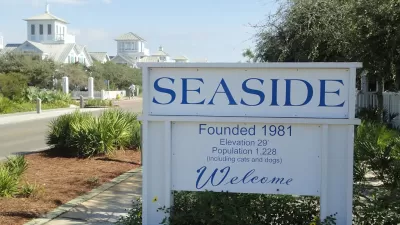Misconceptions about New Urbanism persist.

Over the last 20 years, New Urbanism has become more well-known, cities have become more popular, and even some suburbs have started to sprout walkable downtowns. Yet even so, some of the misconceptions of the 1990s continue to thrive.
For example, the New Geography blog recently ran a post by developer Rick Harrison called "Designing Suburbs: Beyond New Urbanism." The main purpose of this essay seems to be to plug Harrison's developments. But in the course of this discussion, Harrison makes a variety of baseless attacks on New Urbanism.
Harrison begins by stating that the new urbanist solution to sprawl "is to forever banish suburban growth by whatever means necessary—usually through regulation --- [sic] that essentially eliminates choice for the consumer." This statement squeezes three misleading suggestions in less than one sentence.
First, the suggestion that new urbanists seek to "banish suburban growth" implies that new urbanists are against suburbs. But in fact, many of the most highly publicized new urbanist developments, such as Kentlands and King Farm in suburban Washington and Celebration in suburban Orlando, are in suburbs. In fact, urbanists often criticize new urbanists for being too pro-suburban; for example, Alex Marshall calls New Urbanism "a more benevolent sprawl."
Second, it implies that new urbanists are obsessed with government regulation. It is true that new urbanist zoning codes exist, in the form of form-based codes. But in some ways, form-based codes such as the SmartCode can be less restrictive than typical suburban zoning, for example: they sometimes allow more businesses near residential areas than would a typical code, and allow somewhat more density than some suburban codes.
Third, it implies that the new urbanist solution seeks to "eliminate choice for the consumer." But the overwhelming majority of post-1950 American construction is sprawl. Given this fact, anything that isn't sprawl actually increases consumer choice.
Harrison also panders to density-phobia, writing that "restricting how many families can be sardined* into an acre of land (the definition of density) has absolutely nothing to do with affordability—if it did the New Urban projects would be the most affordable, not the most expensive." First of all, new urbanist projects are often (unfortunately from my perspective) not always very dense. For example, Kentlands has 7.2 housing units per acre, barely enough to support minimal bus service. But leaving aside that fact, the reason new urbanist areas are expensive is because there is not enough of them to satisfy consumer demand. If more of them were built, they would be cheaper. And if lack of density equaled affordability, estate home suburbs on two-acre lots would be the least expensive suburbs which of course is not the case. (For example, in Great Falls, Virginia, one of Washington's estate-home suburbs, the average detached home sells for about $1.4 million).
Harrison next claims that "If a developer could increase profits by proposing a 20 story multi-family building on their suburban land they would seek an approval. But this runs up against demonstrated consumer preference: suburban dwellers...seek the most home on the largest lot within their budget." This is the old "sprawl exists therefore consumers want it" scam.
Why is it a scam? Because it overlooks the role of zoning. A developer can propose a 20-story building in the middle of nowhere, but in many neighborhoods (even most urban neighborhoods) the city might not grant the developer's application because current zoning does not allow it, and neighborhood objections might prevent the developer from getting a rezoning. (Which is not to say, of course, that the developer can always make the most money with the 20-story high rise; I argue only that in the absence of zoning and of the "neighborhood veto," taller buildings, as well as more dense low-rises, would be more common than they are.)
Right now, I am writing a book about the role of government regulation in creating sprawl—but I started with some reservations, since I wondered if my points were so obvious that perhaps they didn’t need additional publicity. Harrison's essay suggests that there is still work to be done.

Maui's Vacation Rental Debate Turns Ugly
Verbal attacks, misinformation campaigns and fistfights plague a high-stakes debate to convert thousands of vacation rentals into long-term housing.

Planetizen Federal Action Tracker
A weekly monitor of how Trump’s orders and actions are impacting planners and planning in America.

In Urban Planning, AI Prompting Could be the New Design Thinking
Creativity has long been key to great urban design. What if we see AI as our new creative partner?

King County Supportive Housing Program Offers Hope for Unhoused Residents
The county is taking a ‘Housing First’ approach that prioritizes getting people into housing, then offering wraparound supportive services.

Researchers Use AI to Get Clearer Picture of US Housing
Analysts are using artificial intelligence to supercharge their research by allowing them to comb through data faster. Though these AI tools can be error prone, they save time and housing researchers are optimistic about the future.

Making Shared Micromobility More Inclusive
Cities and shared mobility system operators can do more to include people with disabilities in planning and operations, per a new report.
Urban Design for Planners 1: Software Tools
This six-course series explores essential urban design concepts using open source software and equips planners with the tools they need to participate fully in the urban design process.
Planning for Universal Design
Learn the tools for implementing Universal Design in planning regulations.
planning NEXT
Appalachian Highlands Housing Partners
Mpact (founded as Rail~Volution)
City of Camden Redevelopment Agency
City of Astoria
City of Portland
City of Laramie



























